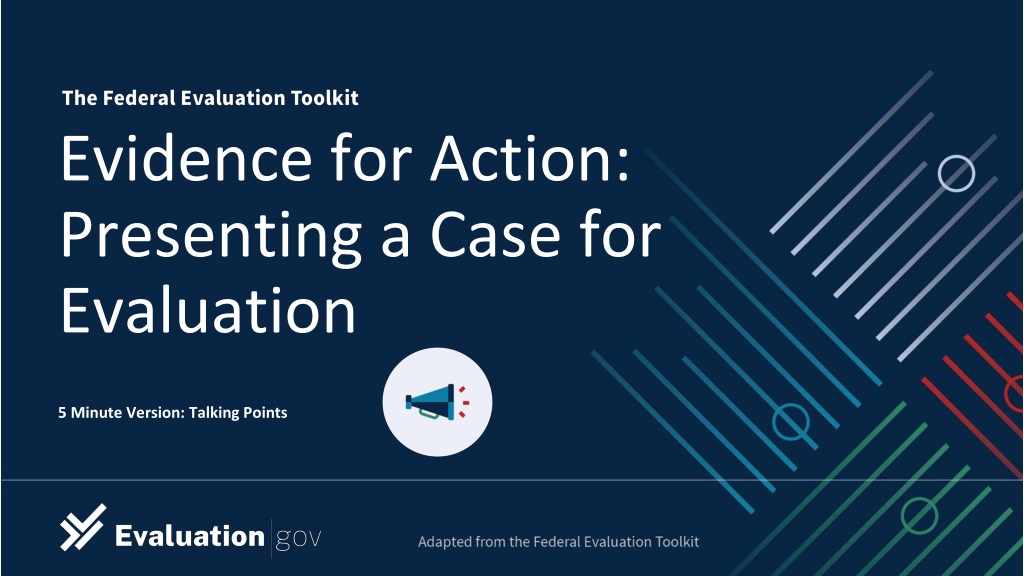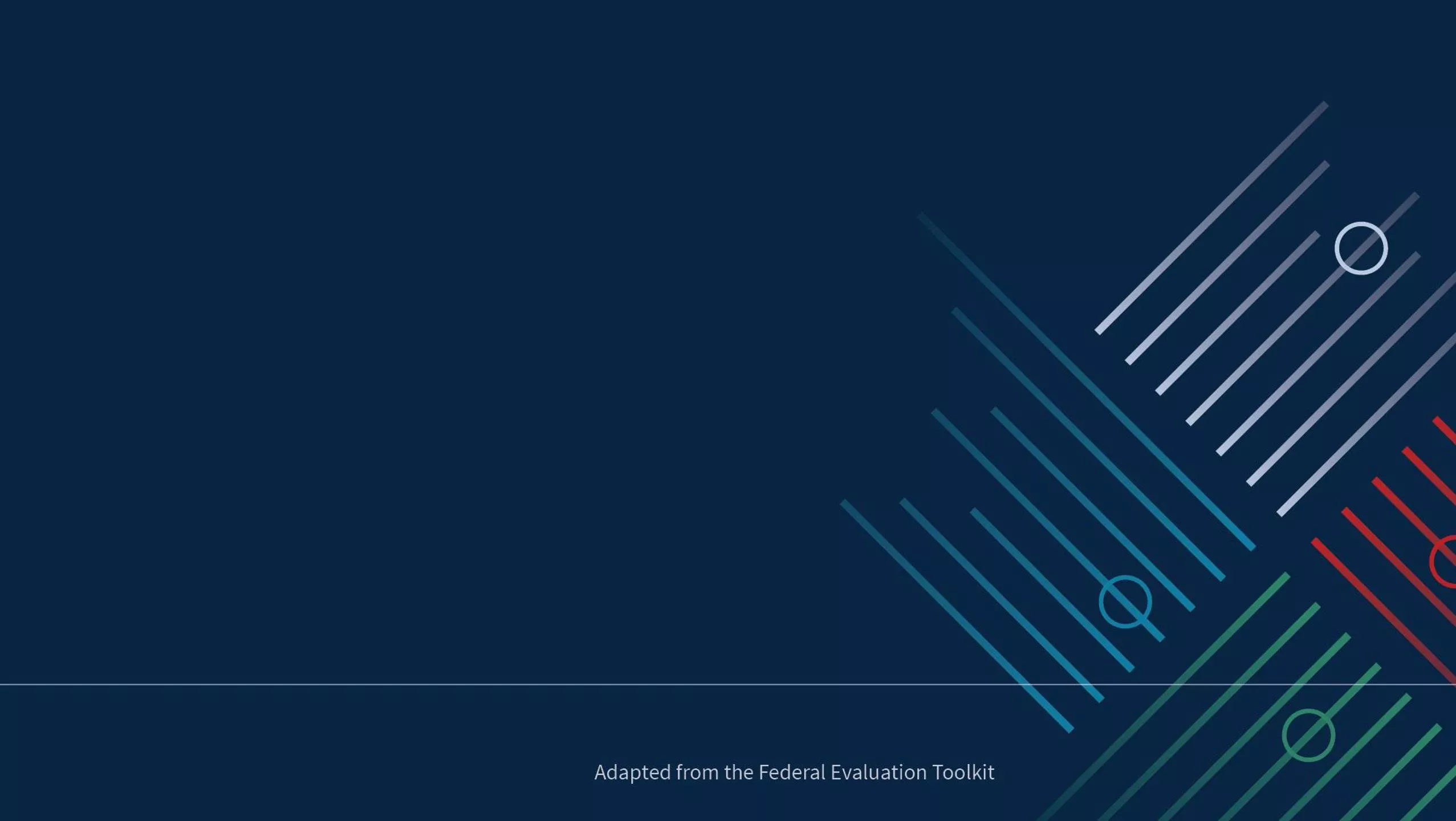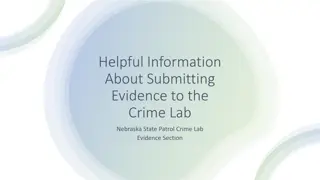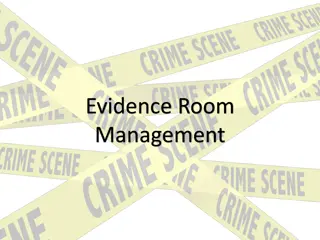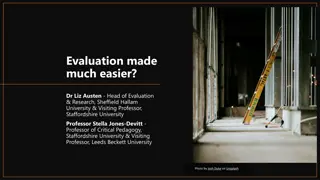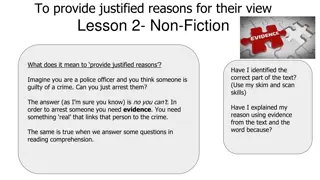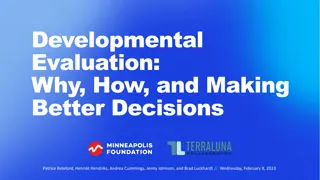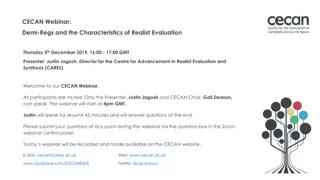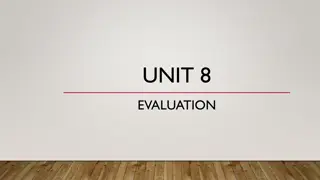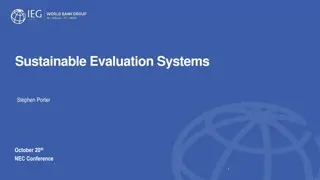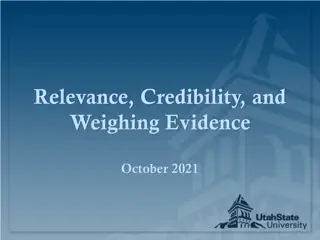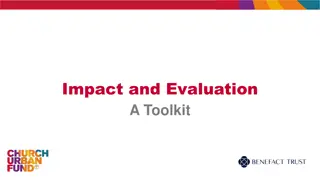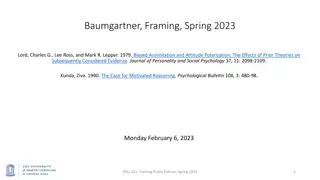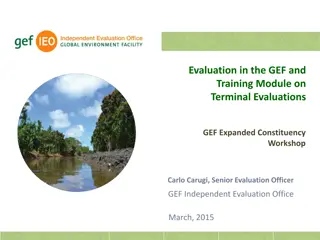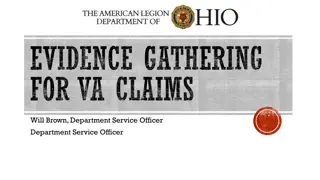Presenting a Case for Evaluation: Evidence for Action
This content highlights the importance of evaluation as a tool for assessing objectives, justifying funding requests, and improving processes. It presents case studies on evaluating impacts and factors influencing flood insurance coverage, advocating for evidence-based decision-making.
Download Presentation

Please find below an Image/Link to download the presentation.
The content on the website is provided AS IS for your information and personal use only. It may not be sold, licensed, or shared on other websites without obtaining consent from the author. Download presentation by click this link. If you encounter any issues during the download, it is possible that the publisher has removed the file from their server.
E N D
Presentation Transcript
Evidence for Action: Presenting a Case for Evaluation 5 Minute Version: Talking Points
2 5 Minute Version: Talking Points Evaluation is a Tool to Answer Questions Are we meeting our objectives and reaching our goals? Evidence to demonstrate success Justify funding requests Continuous quality improvement What works, for whom, under what circumstances, and why? Do we have the right people in the right places? How can we improve processes or workstreams?
3 5 Minute Version: Talking Points Evaluating Impact: Department of Labor National Job Corps Questions about Impact Twenty years after random assignment, what were the impacts of Job Corps on participants annual employment and earnings overall and by age group? What were impacts on types of employment (hourly wage and salaried employment, contractor employment, and self-employment); the receipt of SSDI benefits; and spouse employment? Did the program have an effect on tax filing, liabilities, and balances due? Selected Findings Twenty-year results similar to results from the nine-year study. Positive program effects persisted for the 20- to 24-year-olds in the longer term, but the effects did not grow. No evidence of long-term program effects on employment and earnings for the overall sample or for the 16- to 19-year-olds.
4 5 Minute Version: Talking Points Evaluating Factors Influencing Flood Insurance Coverage for Single-Family Homes in Two States (Pilot) Questions about Implementation Examine the number and proportion of homes located in Special Flood Hazard Areas (SFHAs) that have mortgages secured by the Federal Housing Authority (FHA). Using National Flood Insurance Program (NFIP) data, determine whether FHA single-family home mortgages in SFHAs comply with FHA requirement to carry flood insurance. Explore the relationship between flood insurance coverage and premiums, claims against NFIP, and loan performance. Selected Findings Percentage of FHA single-family properties inside SFHAs were relatively small compared with those outside SFHAs, although exposure to flood risk in 2019 was much higher in Florida (about 20%) than in North Carolina (about 5%). On average, flood insurance coverage rate was significantly larger for properties with FHA- insured mortgages inside an SFHA than those outside an SFHA. Flood insurance coverage does not significantly matter when determining default rates for FHA- insured properties inside or outside an SFHA.
5 5 Minute Version: Talking Points Begin with the End in Mind: What Questions Do We Have? What do we want our program to achieve? What keeps us from making progress toward our goals? What enables our agency or program to be most effective? What questions do we have that rigorous and reliable evidence can help answer?
6 5 Minute Version: Talking Points Why Evaluate? A coordinated approach to evaluation will help agencies use taxpayer dollars efficiently and effectively and promote a culture of learning and continuous improvement. Answers questions: What works? How well? For whom? Under what circumstances? Brings rigor and focus on specific questions Findings can inform decisions about allocating limited funds Source: Building and Using Evidence to Improve Government Effectiveness, OMB, 2022.
7 5 Minute Version: Talking Points What is Evaluation? Evaluation is Different From Performance measurement Foundational fact finding Policy analysis Predictive analytics Performance evaluation of staff Basic scientific research and development An assessment using systematic data collection and analysis of one or more programs, policies, and organizations intended to assess their effectiveness and efficiency. Source: Foundations for Evidence-Based Policymaking Act of 2018 (PL 115-435).
8 5 Minute Version: Talking Points Evaluation Builds Evidence Source: OMB, Memorandum M-21-27 (2021).
9 5 Minute Version: Talking Points Evaluation Supports Continuous Quality Improvement Evaluation is a powerful tool for improving a program and increasing its ability to serve people more efficiently and effectively. It gives programs an opportunity to test their interventions, adjust services to best meet community needs, and collect data to support their work. Plan Act Do Check Source: AmeriCorps. Evaluation Resources. n.d. https://americorps.gov/grantees-sponsors/evaluation-resources.
10 5 Minute Version: Talking Points How Can Evaluation Support Our Program and Agency? Program and policy planning Program management Performance improvement Communication and engagement Coordination across offices and programs to learn from experience
11 5 Minute Version: Talking Points Evaluation Should Inform Decision-Making Support agency priorities Target resources to what works Strengthen partnerships Improve existing programs Revamp programs that do not work as intended Promote efficient and effective use of public dollars Build trust with transparency and a willingness to continually improve
12 5 Minute Version: Talking Points What s at Risk if We Don t Evaluate? We support a program or policy that does not work. We support a program or policy that hinders agency objectives. We may not have funds to support a program or policy that does work. We can t demonstrate program or policy value. We can t show ways to improve. Existing evidence is often limited, outdated, or can t be generalized. Evaluation can fill key gaps in our knowledge of what works and why.
13 5 Minute Version: Talking Points Evaluation is a Key Agency Function Program evaluation is a key agency function to support its mission. Agencies are required to make the investments needed to support evaluation: Planning Time Funding Staff Sources: Foundations for Evidence-Based Policymaking Act of 2018 (Public Law 115-435); Memorandum M-21- 2 (OMB); Memorandum M-19-23 (OMB).
Acknowledgments Partners Danielle Berman (Office of Management and Budget) Lauren Deutsch (Office of Management and Budget) Diana Epstein (Office of Management and Budget) Susan Jenkins (Office of the Assistant Secretary for Planning and Evaluation) Daniel Kim (Office of the Assistant Secretary for Planning and Evaluation) Erika Liliedahl (Office of Management and Budget) Erica Zielewski (Office of Management and Budget) Steering Committee Kelly Bidwell (General Services Administration) Kriti Jain (Administration for Children and Families) Dan Kidder (Centers for Disease Control and Prevention) Rebecca Kruse (Department of Homeland Security)
